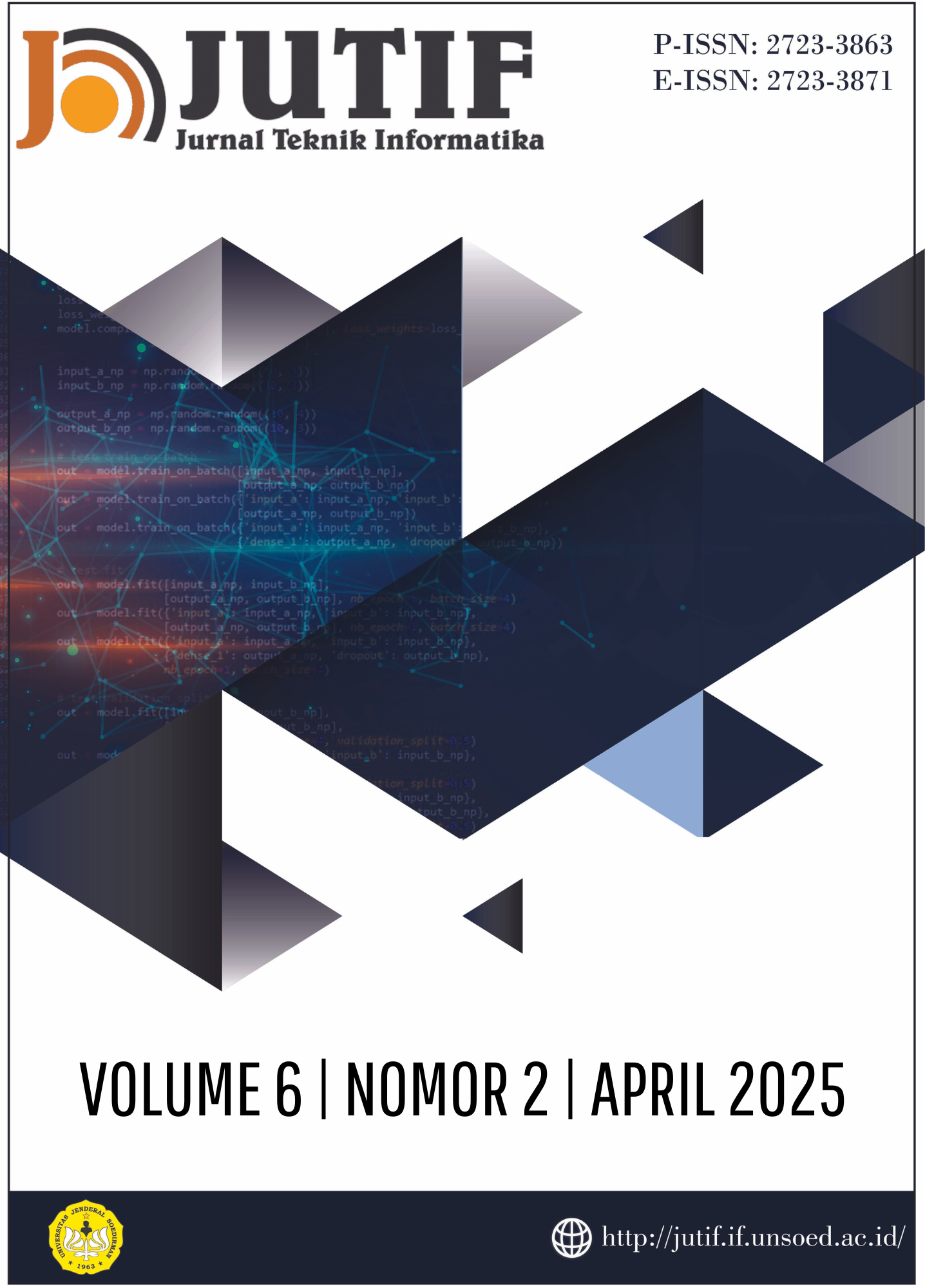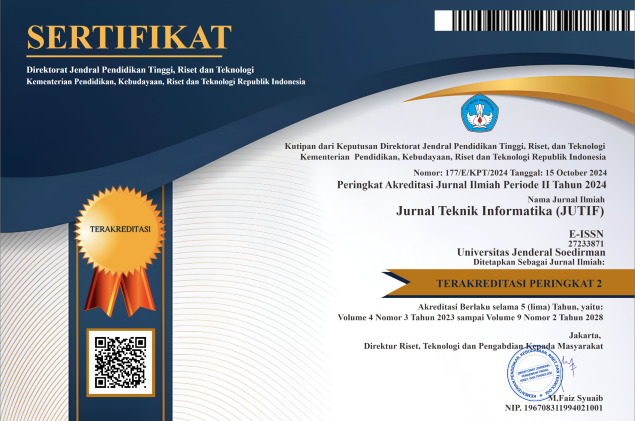Comparative Analysis of Decision Tree, Random Forest, Svm, and Neural Network Models for Predicting Earthquake Magnitude
DOI:
https://doi.org/10.52436/1.jutif.2025.6.2.2378Keywords:
Earthquake Prediction, Machine Learning, Predictive Modeling, Random Forest, Seismic Data, SVMAbstract
This study conducts a comparative analysis of four machine learning algorithms—Decision Tree, Random Forest, Support Vector Machine (SVM), and Neural Network—to predict earthquake magnitudes using the United States Geological Survey (USGS) earthquake dataset. The analysis evaluates each model's performance based on key metrics: Mean Absolute Error (MAE), Root Mean Squared Error (RMSE), and the coefficient of determination (R²). The Random Forest model demonstrated superior performance, achieving the lowest MAE (0.217051), lowest RMSE (0.322398), and highest R² (0.574261), indicating its robustness in capturing complex, non-linear relationships in seismic data. SVM also showed strong performance, with competitive accuracy and robustness. Decision Tree and Neural Network models, while useful, had comparatively higher error rates and lower R² values. The study highlights the potential of ensemble learning and kernel methods in enhancing earthquake magnitude prediction accuracy. Practical implications of the findings include the integration of these models into early warning systems, urban planning, and the insurance industry for better risk assessment and management. Despite the promising results, the study acknowledges limitations such as reliance on historical data and the computational intensity of certain models. Future research is suggested to explore additional data sources, advanced machine learning techniques, and more efficient algorithms to further improve predictive capabilities. By providing a comprehensive evaluation of these models, this research contributes valuable insights into the effectiveness of various machine learning techniques for earthquake prediction, guiding future efforts to develop more accurate and reliable predictive models.
Downloads
References
E. A. Al-Heety, “Evaluation of Return Period and Occurrence Probability of the Maximum Magnitude Earthquakes in Iraq and Surroundings,” Iop Conf. Ser. Earth Environ. Sci., vol. 1300, no. 1, p. 012001, 2024, doi: 10.1088/1755-1315/1300/1/012001.
H. Uyanık, “A Multi-Input Convolutional Neural Networks Model for Earthquake Precursor Detection Based on Ionospheric Total Electron Content,” Remote Sens., vol. 15, no. 24, p. 5690, 2023, doi: 10.3390/rs15245690.
F. Waldhauser and D. P. Schaff, “A Comprehensive Search for Repeating Earthquakes in Northern California: Implications for Fault Creep, Slip Rates, Slip Partitioning, and Transient Stress,” J. Geophys. Res. Solid Earth, vol. 126, no. 11, 2021, doi: 10.1029/2021jb022495.
N. Genzano, C. Filizzola, K. Hattori, N. Pergola, and V. Tramutoli, “Statistical Correlation Analysis Between Thermal Infrared Anomalies Observed From MTSATs and Large Earthquakes Occurred in Japan (2005–2015),” J. Geophys. Res. Solid Earth, vol. 126, no. 2, 2021, doi: 10.1029/2020jb020108.
B. Li, A. Gong, T. Zeng, W. Bao, C. Xu, and Z. Huang, “A Zoning Earthquake Casualty Prediction Model Based on Machine Learning,” Remote Sens., vol. 14, no. 1, p. 30, 2021, doi: 10.3390/rs14010030.
W. Xu, X. Li, and M. Gao, “Temporal Distribution Characteristics of Earthquakes in Taiwan, China,” Front. Earth Sci., vol. 10, 2023, doi: 10.3389/feart.2022.930468.
H. Nimiya, T. Ikeda, and T. Tsuji, “Multimodal Rayleigh and Love Wave Joint Inversion for S‐ Wave Velocity Structures in Kanto Basin, Japan,” J. Geophys. Res. Solid Earth, vol. 128, no. 1, 2023, doi: 10.1029/2022jb025017.
Y. Zhu, X. Yang, F. Liu, Y. Zhao, S. Wei, and G. Zhang, “Progress and Prospect of the Time- Varying Gravity in Earthquake Prediction in the Chinese Mainland,” Front. Earth Sci., vol. 11, 2023, doi: 10.3389/feart.2023.1124573.
J. Lee and T. Hong, “Global Induced Stress Field From Large Earthquakes Since 1900 and Chained Earthquake Occurrence,” Geochem. Geophys. Geosystems, vol. 22, no. 8, 2021, doi: 10.1029/2021gc009927.
S. Zhu, “Estimation of Seismic Hazard Around the Ordos Block of China Based on Spatial and Temporal Variations of B-Values,” Geomat. Nat. Hazards Risk, vol. 12, no. 1, pp. 2048–2069, 2021, doi: 10.1080/19475705.2021.1949394.
Y. Wang, Q. Zhao, K. Qian, Z. Wang, Z. Cao, and J. Wang, “Cumulative Absolute Velocity Prediction for Earthquake Early Warning With Deep Learning,” Comput.-Aided Civ. Infrastruct. Eng., vol. 39, no. 11, pp. 1724–1740, 2023, doi: 10.1111/mice.13065.
R. Norisugi, “Machine Learning Predicts Earthquakes in the Continuum Model of a Rate‐And‐ State Fault With Frictional Heterogeneities,” Geophys. Res. Lett., vol. 51, no. 9, 2024, doi: 10.1029/2024gl108655.
B. Sadhukhan, S. Chakraborty, S. Mukherjee, and R. K. Samanta, “Climatic and Seismic Data- Driven Deep Learning Model for Earthquake Magnitude Prediction,” Front. Earth Sci., vol. 11, 2023, doi: 10.3389/feart.2023.1082832.
R. M. Allen and D. Melgar, “Earthquake Early Warning: Advances, Scientific Challenges, and Societal Needs,” Annu. Rev. Earth Planet. Sci., vol. 47, no. 1, pp. 361–388, 2019, doi: 10.1146/annurev-earth-053018-060457.
M. R. A. Shahmirani, A. Akbarpour, M. R. A. Ramezani, and E. M. Golafshani, “Buildings, Causalities, and Injuries Innovative Fuzzy Damage Model During Earthquakes,” Shock Vib., vol. 2022, pp. 1–11, 2022, doi: 10.1155/2022/4746587.
I. Vrselja, M. Pandžić, and D. Glavaš, “Predicting Earthquake Preparedness Intention Among Croatian Residents: Application of the Theory of Planned Behaviour,” Int. J. Psychol., vol. 58, no. 2, pp. 124–133, 2022, doi: 10.1002/ijop.12882.
L. Fallou, M. Corradini, R. Bossu, and J.-M. Cheny, “Preventing and Debunking Earthquake Misinformation: Insights Into EMSC’s Practices,” Front. Commun., vol. 7, 2022, doi: 10.3389/fcomm.2022.993510.
K. Budiman and Y. Ifriza, “Analysis of earthquake forecasting using random forest,” J. Soft Comput. Explor., vol. 2, no. 2, 2021, doi: 10.52465/joscex.v2i2.51.
A. Jufriansah, “Forecasting the magnitude category based on the flores sea earthquake,” J. Resti Rekayasa Sist. Dan Teknol. Inf., vol. 7, no. 6, pp. 1439–1447, 2023, doi: 10.29207/resti.v7i6.5495.
T. Kim, J. Song, and O. Kwon, “Pre‐ and post‐earthquake regional loss assessment using deep learning,” Earthq. Eng. Amp Struct. Dyn., vol. 49, no. 7, pp. 657–678, 2020, doi: 10.1002/eqe.3258.
“Introduction to Machine Learning,” MIT Press. Accessed: Sep. 25, 2024. [Online]. Available: https://mitpress.mit.edu/9780262043793/introduction-to-machine-learning/
F. Hisyam, “Spatio-Temporal Variation Seismicity Pattern in East Java Between 2002 and 2022 Based on the B-Value and Seismic Quiescence Z-Value,” Trends Sci., vol. 21, no. 4, p. 7608, 2024, doi: 10.48048/tis.2024.7608.
D. A. Ponce, R. W. Simpson, R. W. Graymer, and R. C. Jachens, “Gravity, Magnetic, and High‐ precision Relocated Seismicity Profiles Suggest a Connection Between the Hayward and Calaveras Faults, Northern California,” Geochem. Geophys. Geosystems, vol. 5, no. 7, 2004, doi: 10.1029/2003gc000684.
M. E. Quinteros et al., “Use of Data Imputation Tools to Reconstruct Incomplete Air Quality Datasets: A Case-Study in Temuco, Chile,” Atmos. Environ., vol. 200, pp. 40–49, 2019, doi: 10.1016/j.atmosenv.2018.11.053.
D. Zamanzadeh et al., “Autopopulus: A Novel Framework for Autoencoder Imputation on Large Clinical Datasets,” 2021, doi: 10.1109/embc46164.2021.9630135.
S. Rafsunjani, R. S. Safa, A. A. Imran, S. Rahim, and D. Nandi, “An Empirical Comparison of Missing Value Imputation Techniques on APS Failure Prediction,” Int. J. Inf. Technol. Comput. Sci., vol. 11, no. 2, pp. 21–29, 2019, doi: 10.5815/ijitcs.2019.02.03.
A. U. Chaudhry, W. Li, A. A. Basri, and F. Patenaude, “A Method for Improving Imputation and Prediction Accuracy of Highly Seasonal Univariate Data With Large Periods of Missingness,” Wirel. Commun. Mob. Comput., vol. 2019, pp. 1–13, 2019, doi: 10.1155/2019/4039758.
D.-K. Bui, T. N. Nguyễn, T. Ngo, and H. Nguyen‐Xuan, “An Artificial Neural Network (ANN) Expert System Enhanced With the Electromagnetism-Based Firefly Algorithm (EFA) for Predicting the Energy Consumption in Buildings,” Energy, vol. 190, p. 116370, 2020, doi: 10.1016/j.energy.2019.116370.
L. Qiao, J. Zhu, and Y. Wang, “Modeling of Alloying Effect on Isothermal Transformation: A Case Study for Pearlitic Steel,” Adv. Eng. Mater., vol. 23, no. 5, 2021, doi: 10.1002/adem.202001299.
M. R. Delavar et al., “A Novel Method for Improving Air Pollution Prediction Based on Machine Learning Approaches: A Case Study Applied to the Capital City of Tehran,” Isprs Int. J. Geo- Inf., vol. 8, no. 2, p. 99, 2019, doi: 10.3390/ijgi8020099.
Additional Files
Published
How to Cite
Issue
Section
License
Copyright (c) 2025 Turino Turino, Rujianto Eko Saputro, Giat Karyono

This work is licensed under a Creative Commons Attribution 4.0 International License.



























